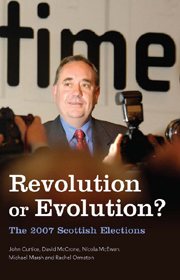Book contents
- Frontmatter
- Contents
- List of Tables
- Preface
- CHAPTER 1 A Watershed Election?
- CHAPTER 2 A Distinctive Scottish Voice? Identities, Values and Attitudes
- CHAPTER 3 What has Devolution Achieved? The Public's View
- CHAPTER 4 Governing Scotland: The People's Preferences?
- CHAPTER 5 Lost Labour Votes? Records, Personalities and Issues
- CHAPTER 6 How the SNP Won
- CHAPTER 7 Do Voters Care about Parties Any More?
- CHAPTER 8 A Personal Vote? How Voters Used the STV Ballot
- CHAPTER 9 Conclusion
- Technical Appendix
- Index
CHAPTER 7 - Do Voters Care about Parties Any More?
Published online by Cambridge University Press: 12 September 2012
- Frontmatter
- Contents
- List of Tables
- Preface
- CHAPTER 1 A Watershed Election?
- CHAPTER 2 A Distinctive Scottish Voice? Identities, Values and Attitudes
- CHAPTER 3 What has Devolution Achieved? The Public's View
- CHAPTER 4 Governing Scotland: The People's Preferences?
- CHAPTER 5 Lost Labour Votes? Records, Personalities and Issues
- CHAPTER 6 How the SNP Won
- CHAPTER 7 Do Voters Care about Parties Any More?
- CHAPTER 8 A Personal Vote? How Voters Used the STV Ballot
- CHAPTER 9 Conclusion
- Technical Appendix
- Index
Summary
We now turn our attention in the third part of our book to the second major change heralded by the 2007 elections, use for the first time of the single transferable vote (STV) electoral system to elect members of Scotland's 32 local councils. As we noted in Chapter 1 this system is radically different from the single-member plurality system that had previously been in use in Scottish local elections. Under that system voters were simply asked to place one ‘X’ against the name of an individual candidate and these votes were tallied to determine who had most votes and thus was elected as the one and only representative for that ward. The new system, in contrast, invited voters to place the candidates in rank order of preference and these preferences were then counted in order to elect as many as three or four councillors in each ward.
Thus STV enables voters to express a more complicated set of choices should they so wish. Under the previous system voters could do no more than indicate that they liked party x or party y best of all. Or if they particularly liked an individual candidate who was standing for a different party they could vote for him or her but have to accept that this meant being unable to express support for their preferred party. Under STV, in contrast, voters can indicate that they like more than one party by giving high preferences to the candidates of more than party.
- Type
- Chapter
- Information
- Revolution or Evolution?The 2007 Scottish Elections, pp. 126 - 157Publisher: Edinburgh University PressPrint publication year: 2009



